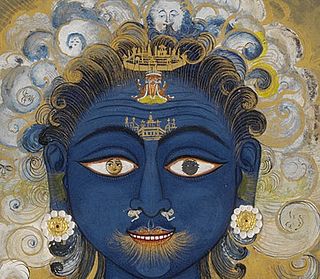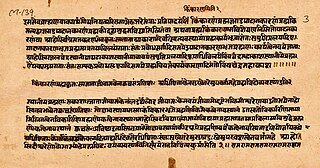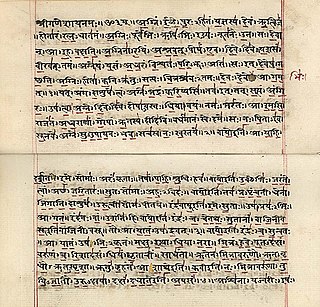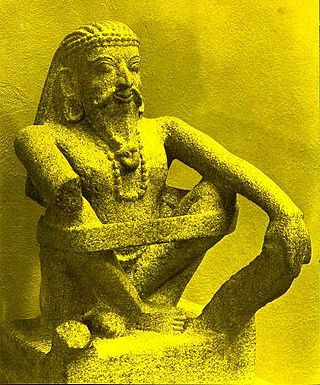Related Research Articles

Brahmaloka or Satyaloka is the abode of Brahma, the creator god, a member of the Trimurti along with Vishnu and Shiva, along with his consort Saraswati. It is also referred to as Brahmapura, in the Puranas. Brahmaloka, described to be 60,000,000 miles above the Prajapati loka and is considered to be of great soteriological significance. The sphere where its inhabitants never again know death, dwelling perpetually in the company of yogins, and drinking the excellent nectar of yoga.

The Yajurveda is the Veda primarily of prose mantras for worship rituals. An ancient Vedic Sanskrit text, it is a compilation of ritual-offering formulas that were said by a priest while an individual performed ritual actions such as those before the yajna fire. Yajurveda is one of the four Vedas, and one of the scriptures of Hinduism. The exact century of Yajurveda's composition is unknown, and estimated by Witzel to be between 1200 and 800 BCE, contemporaneous with Samaveda and Atharvaveda.

Vishishtadvaita, is a highly regarded school of Hindu philosophy belonging to the Vedanta tradition. Vedanta refers to the profound interpretation of the Vedas based on Prasthanatrayi. Vishishta Advaita, meaning "non-duality with distinctions", is a non-dualistic philosophy that recognizes Brahman as the supreme reality while also acknowledging its multiplicity. This philosophy can be characterized as a form of qualified monism, attributive monism, or qualified non-dualism. It upholds the belief that all diversity ultimately stems from a fundamental underlying unity.
Karma is a concept of Hinduism which describes a system in which beneficial effects are derived from past beneficial actions and harmful effects from past harmful actions, creating a system of actions and reactions throughout a soul's (jivatman's) reincarnated lives, forming a cycle of rebirth. The causality is said to apply not only to the material world but also to our thoughts, words, actions, and actions that others do under our instructions. For example, if one does a good thing, something good happens or will happen to them, and the same applies if one does a bad thing. It is said in the Puranas that the lord of karma is the planet Saturn, Shani.

The Vedas are a large body of religious texts originating in ancient India. Composed in Vedic Sanskrit, the texts constitute the oldest layer of Sanskrit literature and the oldest scriptures of Hinduism.
Paramatman or Paramātmā is the Absolute Atman, or supreme Self, in various philosophies such as the Vedanta and Yoga schools in Hindu theology, as well as other Indian religions like Sikhism. Paramatman is the "Primordial Self" or the "Self Beyond" who is spiritually identical with the absolute and ultimate reality. Selflessness is the attribute of Paramatman, where all personality/individuality vanishes.
The oral tradition of the Vedas (Śruti) consists of several pathas, "recitations" or ways of chanting the Vedic mantras. Such traditions of Vedic chant are often considered the oldest unbroken oral tradition in existence, the fixation of the Vedic texts (samhitas) as preserved dating to roughly the time of Homer.

The Shvetashvatara Upanishad is an ancient Sanskrit text embedded in the Yajurveda. It is listed as number 14 in the Muktika canon of 108 Upanishads. The Upanishad contains 113 mantras or verses in six chapters.
Dīrghatamas was an ancient Indian sage well known for his philosophical verses in the Rigveda. He was author of Suktas (hymns) 140 to 164 in the first Mandala (section) of the Rigveda. There was another Dirghatamas by the name Dirghatama Mamteya.

The Rigveda or Rig Veda is an ancient Indian collection of Vedic Sanskrit hymns (sūktas). It is one of the four sacred canonical Hindu texts (śruti) known as the Vedas. Only one Shakha of the many survive today, namely the Śakalya Shakha. Much of the contents contained in the remaining Shakhas are now lost or are not available in the public forum.
Paramananda is a compound Sanskrit word composed of two words, Parama and Ānanda. Parma is usually taken to mean the Highest, the utmost or the most excellent, but actually means - "beyond". And Ānanda, which means, happiness and bliss and most often used to refer to joy though it does not exactly mean these because the original meaning implies permanence rather than just a momentary surge of delight or happiness; it also suggests a deep-seated spiritual emotion that is solidly entrenched. The Upanishadic Seers have used the word, Ānanda, to denote Brahman, the limitless, formless, infinite, indestructible, sole eternal Supreme Being or Sole Reality, to mean, Brahmanmayah, i.e. full of Brahman.
Brihadratha, belonging to the Ikshvaku race, was a king of the Vedic era. This name Brihadratha of a warrior king who was a Maharatha is found in the Rig Veda. The word, Brihadratha, means the Mighty Warrior. He appears at the beginning of the Maitri Upanishad after he had renounced his kingdom in favour of his son, seeking for himself relief from the endless cycle of birth and rebirth. No other information about him or his period is available in this text or in any other text. Maitri Upanishad belongs to the Maitrayaniya branch of Krishna Yajur Veda, which upanishad was taught to Sakayana by Maitri or Maitreya, the son of Mitra. Brihadratha chose the knowledge of the Self when he was offered a boon. He gave up his home and possessions and thereafter assisted by Sakayanya even renounced the “I-ness” of his body.
Jivatva means – the state of life or the state of the individual soul. Jivatva is the state of life of the Jiva, the living entity, which is a particular manifestation of Atman, the embodied being limited to psycho-physical states, and the source of avidya that suffers (repeated) transmigration as result of its actions. Until ignorance ceases the Jiva remains caught in experience of the results of actions bringing merit and demerit, and in the state of individuality (jivatva), and so long as the connection with the intellect as conditioning adjunct lasts, so long the individuality and transmigration of soul lasts.
Prajña or Pragya as प्रज्ञा, प्राज्ञ and प्राज्ञा is used to refer to the highest and purest form of wisdom, intelligence and understanding. Pragya is the state of wisdom which is higher than the knowledge obtained by reasoning and inference.
Kasaya is attachment to worldly objects and is an obstacle in the path leading to Nirvikalpa Samadhi: it is overcome through viveka, discrimination.
Trishna means – 'thirst', 'aspiration', 'longing', 'craving' or 'lusty desires', or as तृष्णज् meaning covetous, greedy or thirsting. Trishna is the Eighth Nidana, spiritual love.
Madhu-vidya is described in the Brihadaranyaka Upanishad II.v.1-19, and in the Chandogya Upanishad III 1-5. Madhu-vidya or 'Honey-knowledge' is that of the supreme Bliss of the Self; it is an important Vedic teaching. This knowledge is meant to be communicated by the teacher to the disciple, by father to the son – who is worthy and inwardly ready. Indra taught Madhu-vidya to Rishi Dadhichi with a warning that it should not be communicated to anyone else.

The Jabali Upanishad, also called Jabalyupanishad, is a Sanskrit text and one of the minor Upanishads of Hinduism. It is attached to the Samaveda, and classified as is one of the Shaiva Upanishads.

The Mantrika Upanishad is a minor Upanishad of Hinduism. The Sanskrit text is one of the 22 Samanya Upanishads, is part of the Vedanta and Yoga schools of Hindu philosophy literature, and is one of 19 Upanishads attached to the Shukla Yajurveda. In the Muktika canon, narrated by Rama to Hanuman, it is listed at number 32 in the anthology of 108 Upanishads.

The Trishikhibrahmana Upanishad, also known as Trisikhibrahmanopanisad, is one of the minor Upanishads of Hinduism and a Sanskrit text. It is attached to the Shukla Yajurveda and is classified as one of the 20 Yoga Upanishads.
References
- ↑ "Shiva, Shakti and Jiva – SivaSakti".
- ↑ Gelbert, Carlos (2011). Ginza Rba. Sydney: Living Water Books. ISBN 9780958034630.